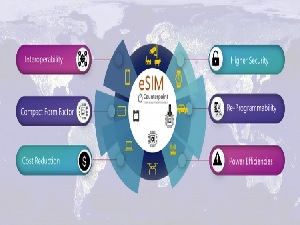



Date:05/07/19
 Shipments of eSIM-based devices are set to reach almost two billion units by 2025, up from 364 million in 2018, a new report by Counterpoint Research said on Monday.
Shipments of eSIM-based devices are set to reach almost two billion units by 2025, up from 364 million in 2018, a new report by Counterpoint Research said on Monday.
According to Counterpoint's "Emerging Technology Opportunities Service" report, this would be mainly due to smartphones and enterprise Internet of Things (IoT) devices.
Also, a majority of eSIM-based devices would have a hardware chip-based eSIM solution until 2025, and after that, it would see a rise in the adoption of integrated SIM-based solutions.
"The growth of eSIMs will revolutionise how the connectivity across the devices will be activated and managed. The eSIM's compact form factor offers significant space reduction for device manufacturers along with potentially higher security, re-programmability, and power efficiencies over the traditional SIM card solutions," Satyajit Sinha, Research Analyst, Counterpoint Research, said in a statement.
"For operators, eSIMs can significantly reduce the SIM distribution and activation costs with the potential to generate higher roaming revenues. eSIM offers great benefits for consumers and enterprise customers to seamlessly choose, activate, connect and manage connectivity on their devices."
Adoption of eSIMs in smartphones should also drive major volume growth with the adoption of eSIM by top players such as Apple and Google.
Other connected devices such as mobile hotspots, routers, connected PCs, drones and smartwatches would grow at a higher CAGR due to a relatively smaller base of adoption right now.
"Automotive and enterprise IoT devices will continue to remain high on the eSIM adoption curve in future. Further, the eSIM activation rate in cellular enterprise IoT devices will also be much higher than consumer IoT devices," Neil Shah, Research Director, Counterpoint Research said.
eSIM-based devices shipments to reach 2 billion by 2025
 Shipments of eSIM-based devices are set to reach almost two billion units by 2025, up from 364 million in 2018, a new report by Counterpoint Research said on Monday.
Shipments of eSIM-based devices are set to reach almost two billion units by 2025, up from 364 million in 2018, a new report by Counterpoint Research said on Monday.According to Counterpoint's "Emerging Technology Opportunities Service" report, this would be mainly due to smartphones and enterprise Internet of Things (IoT) devices.
Also, a majority of eSIM-based devices would have a hardware chip-based eSIM solution until 2025, and after that, it would see a rise in the adoption of integrated SIM-based solutions.
"The growth of eSIMs will revolutionise how the connectivity across the devices will be activated and managed. The eSIM's compact form factor offers significant space reduction for device manufacturers along with potentially higher security, re-programmability, and power efficiencies over the traditional SIM card solutions," Satyajit Sinha, Research Analyst, Counterpoint Research, said in a statement.
"For operators, eSIMs can significantly reduce the SIM distribution and activation costs with the potential to generate higher roaming revenues. eSIM offers great benefits for consumers and enterprise customers to seamlessly choose, activate, connect and manage connectivity on their devices."
Adoption of eSIMs in smartphones should also drive major volume growth with the adoption of eSIM by top players such as Apple and Google.
Other connected devices such as mobile hotspots, routers, connected PCs, drones and smartwatches would grow at a higher CAGR due to a relatively smaller base of adoption right now.
"Automotive and enterprise IoT devices will continue to remain high on the eSIM adoption curve in future. Further, the eSIM activation rate in cellular enterprise IoT devices will also be much higher than consumer IoT devices," Neil Shah, Research Director, Counterpoint Research said.
Views: 628
©ictnews.az. All rights reserved.Similar news
- Azerbaijani project to monitor disease via mobile phones
- Innovative educational system to be improved under presidential decree
- NTRC prolongs license of two TV and radio organizations for 6 years
- Azerbaijan establishes e-registry for medicines
- Azerbaijani museum introduces e-guide
- Nar Mobile opens “Nar Dunyasi” sales and service center in Siyazan city
- International conference on custom electronic services held in Baku
- OIC secretary general to attend COMSTECH meeting in Baku
- Azerbaijan develops earthquake warning system
- New law to regulate transition to digital broadcasting in Azerbaijan
- Azerbaijani State Social Protection Fund introduces electronic digital signature
- Intellectual traffic management system in Baku to be commissioned in December
- Tax Ministry of Azerbaijan started receiving video-addresses
- World Bank recommends Azerbaijan to speed up e-service introduction in real estate
- Azerbaijan to shift to electronic registration of real estate





















